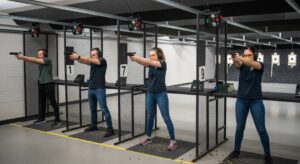Frequently Asked Questions
Can anyone take a firearms training course?
Firearms training courses are designed for responsible individuals who wish to learn safe handling and responsible use of firearms. Enrollment may be subject to eligibility requirements based on local regulations and course prerequisites.
What is the best way to learn firearms safety?
The best way to learn firearms safety is to enroll in a comprehensive training program led by experienced instructors who can provide hands-on guidance and practical knowledge on safe handling, storage, and use of firearms.
How often should I practice firearms training?
Regular firearms training is recommended to maintain proficiency. Experts suggest practicing at least once a month to ensure safety and effectiveness in handling firearms.
How often should tactical training be conducted?
Tactical training should be conducted regularly to maintain and improve skills necessary for effective response to evolving security threats. The optimal frequency depends on the specific needs and risk profile of the individual or organization.
What are the different types of firearms training?
Phylax Global offers a range of specialized firearms training programs, including tactical shooting, weapon handling, and safety courses tailored to clients' specific needs and security challenges.
What is the importance of scenario-based tactical training?
Scenario-based tactical training is essential for preparing individuals to respond effectively to real-world security threats. It allows them to develop critical decision-making skills and practice their techniques in simulated, high-stress situations, enhancing their overall preparedness.
How do I choose a firearms training instructor?
Choosing a firearms training instructor requires evaluating their credentials, experience, and teaching methods to ensure they can provide effective and safe training tailored to your specific needs.
What are the key components of effective tactical training?
The key components of effective tactical training are a combination of hands-on instruction, scenario-based exercises, and guidance from experienced instructors with real-world expertise to develop practical skills and decision-making abilities for modern security challenges.
What are the benefits of tactical training for law enforcement?
Tactical training for law enforcement enhances officers' situational awareness, decision-making skills, and physical preparedness, enabling them to respond more effectively to evolving security threats and ensure the safety of themselves and the public.
What are the laws regarding firearms training in my state?
The laws regarding firearms training in your state vary based on local regulations. It is recommended to research the specific requirements and restrictions in your area to ensure compliance with all applicable laws and regulations.
What are the benefits of professional firearms training?
Professional firearms training enhances safety, accuracy, and confidence in handling firearms. It equips individuals with the necessary skills and knowledge to responsibly use and maintain firearms for personal or professional needs.
Can tactical training reduce stress in high-pressure situations?
Tactical training can indeed help reduce stress in high-pressure situations by equipping individuals with the necessary skills, confidence, and situational awareness to effectively navigate and respond to challenging scenarios.
How does tactical training enhance team cohesion?
Tactical training enhances team cohesion by fostering effective communication, building trust, and cultivating a shared understanding of roles and responsibilities, enabling teams to work seamlessly towards a common goal.
Can firearms training improve my self-defense skills?
Firearms training can significantly improve your self-defense skills by teaching you proper handling, accuracy, and tactical awareness to effectively protect yourself in critical situations.
How does tactical training improve situational awareness?
Tactical training enhances situational awareness by developing an individual's ability to rapidly assess their environment, identify potential threats, and respond effectively to mitigate risks.
Can civilians participate in tactical training programs?
Yes, civilians can participate in the tactical training programs offered by Phylax Global. The training is designed to be accessible and beneficial for individuals seeking to enhance their personal security and preparedness, regardless of their professional background.
What is the role of tactical training in military operations?
Tactical training is essential in military operations, as it equips personnel with the skills, decision-making abilities, and situational awareness required to navigate complex and rapidly evolving battlefield scenarios effectively.
What prerequisites are needed for firearms training?
The prerequisites for firearms training typically include a valid firearms license, basic safety knowledge, and a willingness to learn. Participants may also be required to undergo background checks and provide medical documentation.
How can I assess firearms training quality?
Assessing the quality of firearms training involves evaluating the instructors' credentials, training methods, and emphasis on safety. Look for programs led by experienced veterans with a proven track record in real-world applications.
What scenarios are included in tactical training?
The tactical training programs at Phylax Global cover a range of real-world scenarios, including active shooter response, hostage rescue, and counter-terrorism operations, equipping individuals with the skills to handle critical security challenges.
How is firearms safety taught in courses?
Firearms safety is a core component of the training courses, emphasizing safe handling, storage, and use of firearms through hands-on demonstrations, lectures, and practical exercises under close supervision of experienced instructors.
What age restrictions exist for firearms training?
The age restrictions for firearms training vary by location, with some programs requiring participants to be at least 18 years old, while others may have lower age limits with parental supervision.
How can tactical training improve decision-making skills?
Tactical training can improve decision-making skills by enhancing situational awareness, stress management, and critical thinking, enabling individuals to make informed choices under pressure and adapt to evolving circumstances.
How does tactical training address real-world threats?
Tactical training addresses real-world threats by equipping individuals with practical skills, situational awareness, and decision-making capabilities to effectively respond to and mitigate contemporary security challenges.
What equipment is required for firearms training?
The equipment required for firearms training typically includes a firearm, appropriate ammunition, eye and ear protection, and a safe training environment.
How can I find local tactical training programs?
To find local tactical training programs, you can search for specialized security or defense training providers in your area and review their course offerings. Many offer customized training to meet specific security needs.
What role does physical fitness play in tactical training?
Physical fitness is essential in tactical training, as it enhances the operator's endurance, agility, and overall performance during high-intensity operations, ensuring they can effectively respond to dynamic security challenges.
How can I evaluate a firearms training instructor?
Evaluating a firearms training instructor involves assessing their credentials, experience, teaching methods, and ability to address specific needs. Look for instructors with extensive real-world expertise, a focus on safety, and a customized approach to your training requirements.
What are common mistakes in firearms training?
Common mistakes in firearms training include inadequate safety protocols, improper stance and grip, and a lack of realistic scenario-based practice. Effective training emphasizes holistic competence and adapting to dynamic, real-world threats.










